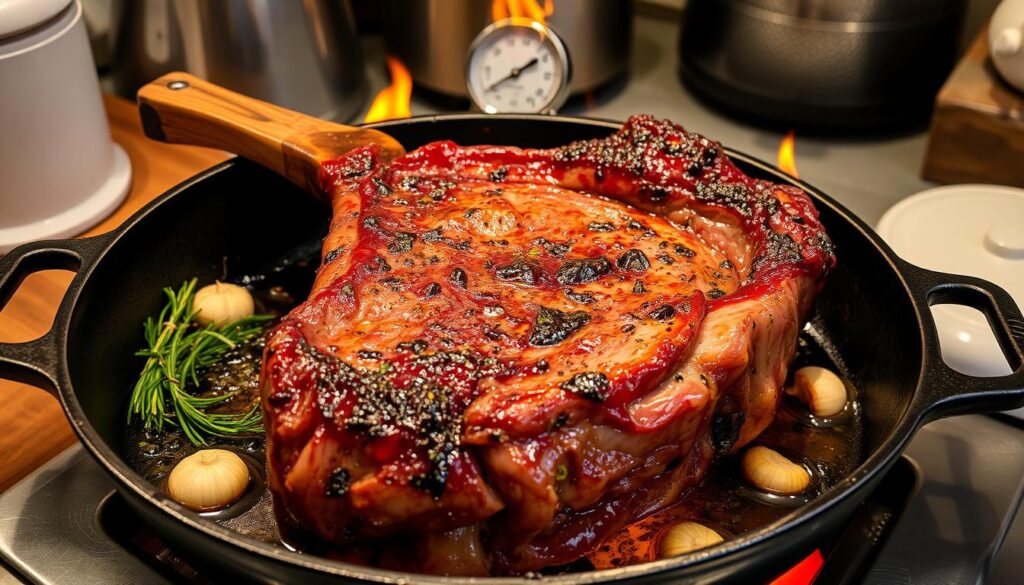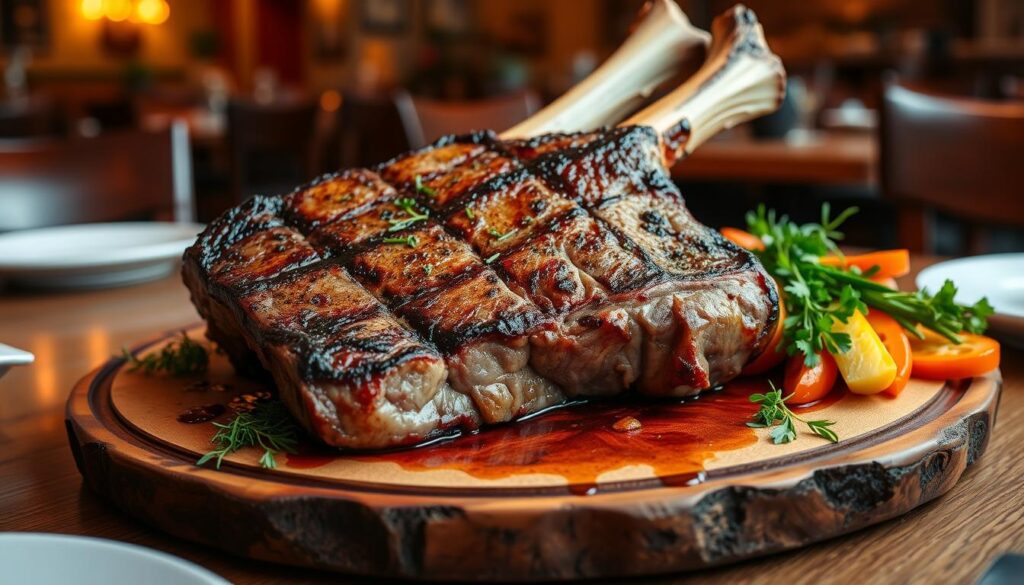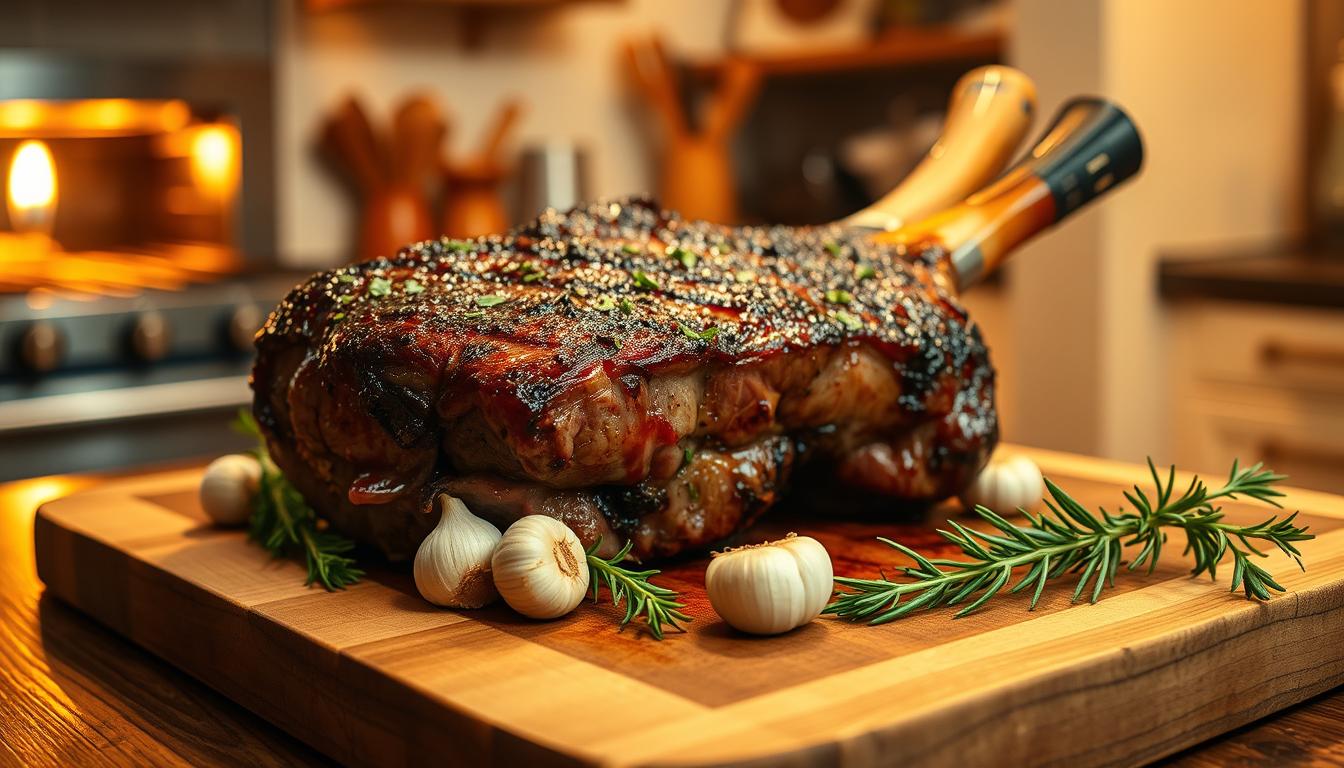When cooking a tomahawk steak, you want the best method to enhance its flavor and tenderness. The reverse sear method is a standout for steak enthusiasts. It ensures even cooking and a juicy interior. Start by baking the steak at 250°F, then finish it in a hot skillet.
The reverse sear method cooks the steak in a low oven and then sears it in a hot skillet. It’s great for tomahawk steak, providing a tender and juicy interior. By following this guide, you’ll master the bake then reverse sear method for perfect tomahawk steaks.
Key Takeaways
- Use the reverse sear method to cook a tomahawk steak for even cooking and a tender, juicy interior.
- Cook the steak in a low-temperature oven, typically set at 250°F, before finishing it off in a hot skillet.
- The bake then reverse sear method is perfect for cooking tomahawk steak, as it ensures a perfect crust on the outside while keeping the inside juicy and tender.
- Cooking duration before the reverse sear takes approximately 60 minutes, though this can vary by steak size.
- Resting time after cooking should be between 10 to 15 minutes to allow the juices to redistribute and the steak to retain its tenderness.
- Use high smoke point oils such as avocado oil, light olive oil, soybean oil, or vegetable oil for basting and cooking.
- Calories per serving of the steak recipe are 407 kcal, with 24g of protein, 33g of fat, and 5g of carbohydrates.
What Is a Tomahawk Steak?
A tomahawk steak is a special type of ribeye steak. It has a long, curved bone and tastes rich and beefy. This steak is tender and looks unique, making it a favorite among steak lovers. There are many ways to cook a tomahawk steak, like grilling, pan-searing, and oven roasting.
The thickness of the steak is important. A tomahawk steak is usually 2 inches thick. This thickness helps it cook evenly and stay tender. You can choose how to cook it, like reverse searing or grilling, based on what you like best.
Some key characteristics of a tomahawk steak include:
- Rich, beefy flavor
- Tender texture
- Long, curved bone
- Typically cut 2 inches thick
- Can be cooked using a variety of steak cooking techniques, including grilling, pan-searing, and oven roasting
A tomahawk steak is packed with protein, with about 46 grams per serving. It also has iron, with about 4 milligrams per serving. But, it’s high in fat and calories. It’s important to think about how you cook it and how much you eat to keep your meal healthy.
| Nutrient | Amount per serving |
|---|---|
| Protein | 46g |
| Iron | 4mg |
| Fat | 36g |
| Calories | 505kcal |
Preparing Your Tomahawk Steak
Preparing your tomahawk steak is all about the details. You need to pick the right steak and season it just right. Also, make sure it’s at room temperature for even cooking.
First, choose a high-quality tomahawk steak. It should be thick, at least 1.5 inches, to handle the reverse sear method well.
Seasoning Techniques
Seasoning is key to bringing out the flavor of your steak. A mix of salt, pepper, and garlic powder is a great start. Feel free to add paprika, thyme, or rosemary for extra taste.
Bringing to Room Temperature
Letting the steak come to room temperature is important. It helps cook the steak evenly, making it tender and juicy. Take it out of the fridge and let it sit for 30-45 minutes before cooking.
By following these steps and using the right seasonings, you’ll make a delicious tomahawk steak. Always remember to bring the steak to room temperature before cooking for the best results.
| Steak Thickness | Recommended Cooking Time |
|---|---|
| 1.5 inches | 1 hour 30 minutes |
| 2 inches | 1 hour 45 minutes |
| 2.5 inches | 2 hours |
Baking the Tomahawk Steak
To get a perfectly cooked tomahawk steak, start by baking it. This step is part of the reverse searing method. Cook the steak in the oven at 225°F before searing it in a hot skillet. This low temperature helps cook the steak evenly and prevents burning.
When baking, think about the steak’s thickness and how done you want it. Thicker steaks need more time, while thinner ones cook faster. The cooking time also depends on the oven temperature and your desired doneness.
The following table provides a guide for baking a tomahawk steak:
| Steak Thickness | Oven Temperature | Cooking Time | Doneness |
|---|---|---|---|
| 1 ½ to 2 inches | 225°F | 15-25 minutes | Rare to Medium-Rare |
| 1 to 1 ½ inches | 225°F | 10-15 minutes | Medium-Rare to Medium |
After baking, check the steak’s doneness with a meat thermometer. For medium-rare, the internal temperature should be 120-125°F. For medium, it should be 130-135°F. For medium-well, aim for 140-145°F.
By following these steps and guidelines, you can achieve a perfectly cooked tomahawk steak. It will have a tender, juicy interior and a crispy, caramelized crust.
Reverse Searing Explained
Cooking tomahawk steaks with reverse searing is a game-changer. It creates a perfect crust on the outside and keeps the inside juicy. You cook the steak in a low oven first, then sear it hot. This way, your steak is cooked evenly and has a great crust.
The secret to reverse searing is the low oven start. It cooks the steak slowly and evenly, so it doesn’t get tough. After it’s cooked to the right temperature, searing it hot creates a crispy crust. It’s a clever mix of cooking methods for amazing results.
What Is Reverse Searing?
Reverse searing cooks the steak in a low oven, between 225-250°F, before searing it hot. This method prevents overcooking. It cooks the steak slowly and evenly, giving you control over the final temperature.
Why It Works for Tomahawk Steaks
Tomahawk steaks are perfect for reverse searing. The low oven cooks the meat tender and easy to chew. Then, searing it hot adds a crispy crust. This technique brings out the best in your steak, making it unforgettable.

- Even cooking: The low-temperature cooking phase ensures that the steak is cooked evenly throughout, preventing hot spots and overcooking.
- Tenderization: The slow cooking process helps to break down the connective tissues in the meat, making it more tender and easier to chew.
- Crispy crust: The subsequent searing phase adds a satisfying crust to the outside, complementing the steak’s natural flavor.
Mastering reverse searing takes your tomahawk steak cooking to new heights. It creates a memorable dining experience that will impress your guests.
| Cooking Technique | Temperature | Time |
|---|---|---|
| Reverse Searing | 225-250°F | 20-25 minutes |
| Searing | High heat | 3-4 minutes per side |
Searing Your Tomahawk Steak
To get a perfect crust on your tomahawk steak, use a cast iron skillet. This skillet holds heat well, making the crust crispy. Make sure the skillet is hot before adding the steak.
Heat the cast iron skillet over high heat and add a bit of oil. When the oil is hot, place the tomahawk steak in the skillet. Sear it for 2 minutes on each side. Use a thermometer to check the steak’s internal temperature, aiming for 130-135 degrees Fahrenheit for medium-rare.
After searing, take the steak out of the skillet and let it rest for a few minutes. This makes the steak tender and flavorful. To add more flavor, baste the steak with butter during the last minute of searing. This will make the crust rich and savory.
Reaching the Perfect Crust
Getting a perfect crust on a tomahawk steak takes practice. But with the right techniques, you can achieve a crispy, caramelized crust. Here are some tips:
- Use a cast iron skillet to sear the steak, as it retains heat well and allows for a crispy crust to form.
- Preheat the skillet over high heat before adding the steak.
- Don’t overcrowd the skillet, as this can lower the temperature and prevent a crispy crust from forming.
- Don’t stir the steak too much, as this can prevent a crust from forming.
Basting with Butter
Basting the steak with butter during the last minute of searing adds extra flavor. It also creates a rich, savory crust. Here’s how to do it:
- Melt a tablespoon of butter in the skillet during the last minute of searing.
- Use a spoon to baste the steak with the melted butter, making sure to coat the entire surface.
- Remove the steak from the skillet and let it rest for a few minutes before serving.
| Steak Temperature | Internal Temperature |
|---|---|
| Rare | 120-130 degrees Fahrenheit |
| Medium-Rare | 130-135 degrees Fahrenheit |
| Medium | 135-145 degrees Fahrenheit |
Serving Your Tomahawk Steak
Serving tomahawk steak is all about the presentation. You want to impress your guests with how it looks and tastes. Start by slicing the steak against the grain for a tender texture.
Here are some tips for serving tomahawk steak:
- Let the steak rest for a few minutes before slicing to allow the juices to redistribute
- Use a sharp knife to slice the steak into thin, even pieces
- Choose sides that complement the steak’s rich flavor, like roasted vegetables or a salad
- Pick a wine that pairs well with the steak’s bold flavor, such as Cabernet Sauvignon or Malbec
Follow these tips to create a memorable meal for your guests. Wine pairing can make your steak even better. Whether it’s for a special dinner or a casual meal, serving tomahawk steak will wow everyone.

Be creative with your slicing techniques and wine pairing to make a memorable meal. Enjoy the delicious taste of your tomahawk steak.
Tips for Perfecting Your Technique
Mastering the reverse searing of a tomahawk steak takes time, but it’s worth it. To get a perfectly cooked steak, avoid overcooking the meat. Try different seasonings to find your favorite flavor. And remember to store leftovers right to enjoy them later.
Avoiding Common Mistakes
Keeping an eye on the steak’s internal temperature is key. Overcooking can ruin a great tomahawk steak. Use a meat thermometer to ensure it’s just right. Also, watch the searing time to avoid burning the outside before the inside is cooked.
Experimenting with Seasonings
Cooking a tomahawk steak is a chance to try new seasoning blends. Create your own rubs or mix herbs and spices to match the steak’s rich flavor. Don’t hesitate to experiment and add your own twist.
Storing Leftovers Properly
If you have leftover tomahawk steak, store it well to keep its quality. Wrap it tightly in plastic or foil and refrigerate for 3-4 days. To reheat, use a skillet or oven, but don’t overcook it.

